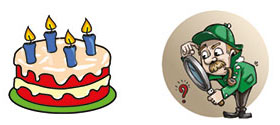Edible technical device: register and eat
27 January 2017
Russian examiners did not favour confectionery. This does not mean that they are diabetics; they simply felt uneasy when an application came seeking protection for a confectionery patent for a utility model. That was application number 2014136036/13. By that time the law had been changed so that the application had to be examined in its substance not only for formal requirements. It was examined and rejected soon after. The applicant appealed against the decision of the examiner. The Board of Appeal of the Patent Office tested (tasted) it for patentability and came to a different conclusion. Why?
The original claims of the utility model were worded in the following way:
- Confectionery article made of chocolate containing a base 3D figurative shape with protrusions and edible colour coating, the colour of the coating being different from the colour of the base characterised in that the edible coating is located on the protrusions, the portions outside the protrusions being free from coating.
- The article according to claim 1 characterised in that the surface covered by the edible coating constitutes less than 40% of the overall surface of the article.
- The article according to claim 1 characterised in that the reflection coefficient of the edible colour coating is greater than the reflection coefficient of the base surface.
- The article according to claim 1 characterised in that each colour coordinate of reflected light from the coated surface is different by more than 10% to the colour coordinates of the base surface.
- The article according to claim 1 characterised in that the edible colour coating is made adapted to enhance visual perception of the volume of the article and the surface irregularities because of the shade and light pattern by means of applying corrective coating on parts of the surface.
The Patent Office examined the patent application and refused the grant of a patent arguing that the proposed solution is not a technical solution referring to a device and thus cannot be protected as a utility model.
The applicant did not agree with the examiner and appealed the official action. The appeal board of the Patent Office examined the application again and found that the proposed utility model is different from the prior art in that the base of the shaped article is made with protrusions; the edible colour coating is located on the protrusions; and portions outside the protrusions are free from coating. The appeal board did not agree with the examiner in that the claimed feature "edible colour coating located on the protrusions reduces the consumption of edible colour agent and improves organoleptic properties of the article" is not essential. According to the appeal board the feature "the edible colour coating located on the protrusions" characterises structural elements in the form of protrusions, the portions outside protrusions are free from coating. Those features are essential for achieving a technical result because the coating located on the protrusions is quickly dissolved by the consumer's saliva, etc.
The appeal board left without comment the statement of the examiner to the effect that the claimed subject matter is not a technical solution referring to a device. It may be assumed that the board of appeal did recognise the claimed confectionery as a technical device. The Patent Office regulations define a device as an article having no composite parts, or consisting of two or more parts connected by means of assembly operations and being in functional and structural unity. Formally, the confectionery article falls under that definition though the consumer will probably feel awkward realising that he eats a technical device.
On the flip side of things and unrelated to the above, there was a patent application consisting of a traffic control camera and a distant computer. Both parts of the device were connected by wires or radio waves. The Patent Office refused to recognise it as an invention because there was no "structural unity" between the parts (in other words they were not in one box) which was somewhat strange. It seems formal considerations sometimes take precedence over common sense. Especially against the background of the confectionery patent. Or, as one of the observers said with regard to this last, members of the appeal board have a sweet tooth and they could not resist temptation.










